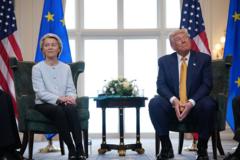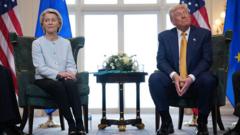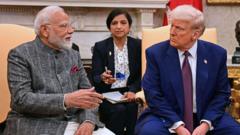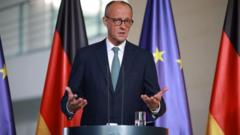The recent EU-US tariff deal has sparked criticism among European leaders who feel the agreement remains incomplete and burdensome. The new 15% tariff is an improvement from earlier proposals, but disagreements persist regarding specific sectors, and many EU countries are likely to face disproportionate impacts.
EU Negotiators Voice Discontent Over Incomplete US Trade Deal

EU Negotiators Voice Discontent Over Incomplete US Trade Deal
Despite recent concessions, European leaders express dissatisfaction with unresolved details in the EU-US tariff agreement.
Since the announcement of the EU-US trade agreement, which seemed a relief to many after months of uncertainty, unease has surfaced in Europe regarding the details and implications of the deal. European Commission chief Ursula von der Leyen stood alongside US President Donald Trump, presenting the agreement as a significant step forward and avoiding the severe 30% tariffs initially threatened. However, many leaders and industry experts now argue that the deal's benefits are overstated, with substantial discrepancies yet to be resolved.
The newly established 15% tariff, while lower than previously suggested levels, represents a substantial hike from the prior average rate of 4.8%. Many European officials agree that, although it could have been worse, the deal's lack of rigor raised concerns. The finance minister of Germany, Lars Klingbeil, acknowledged the need for an agreement but wished for tougher negotiations from the EU side to protect various sectors better.
Despite the presentation of a united front by the US, key differences between the two parties have come to light. The agreement, highlighted by the White House as a framework for "historic structural reforms," lacks legal binding, with the European Commission emphasizing it as a set of political commitments. This distinction raises questions about the future execution of the agreement and suggests that the negotiations are far from over.
Several sectors are directly affected by the proposed tariffs, with the pharmaceutical and semiconductor industries serving as points of contention. The US claims these sectors will fall under the 15% tariff rate, while the EU insists they will maintain their current rate until new global tariffs are agreed upon. The discord surrounding the oil and natural gas sector is equally contentious, with both sides offering contradictory statements regarding future purchasing commitments.
As the US continues to push for additional purchases and investments, the EU emphasizes its inability to mandate private sector actions. This disconnect brings uncertainty to other reported commitments, such as the purported military equipment purchases and future investments up to $600 billion.
Widespread effects from the tariff agreement will vary across EU member states, with Germany, Ireland, and Italy set to feel the most strain. For instance, German automotive sectors, heavily reliant on US exports, could face significantly increased costs that some fear will detrimentally affect the country's economy. With concerns mounting over compensation for affected industries, experts warn that such measures would ultimately transfer the financial burden onto European taxpayers.
As European leaders continue to critique the deal's flaws and unresolved issues, they face pressure to take a stronger stance against the US, highlighting the need for a measured but firm approach in future negotiations. With many details still under discussion, the next phase of talks is critical for establishing equitable terms that protect EU interests against further trade imbalances.



















